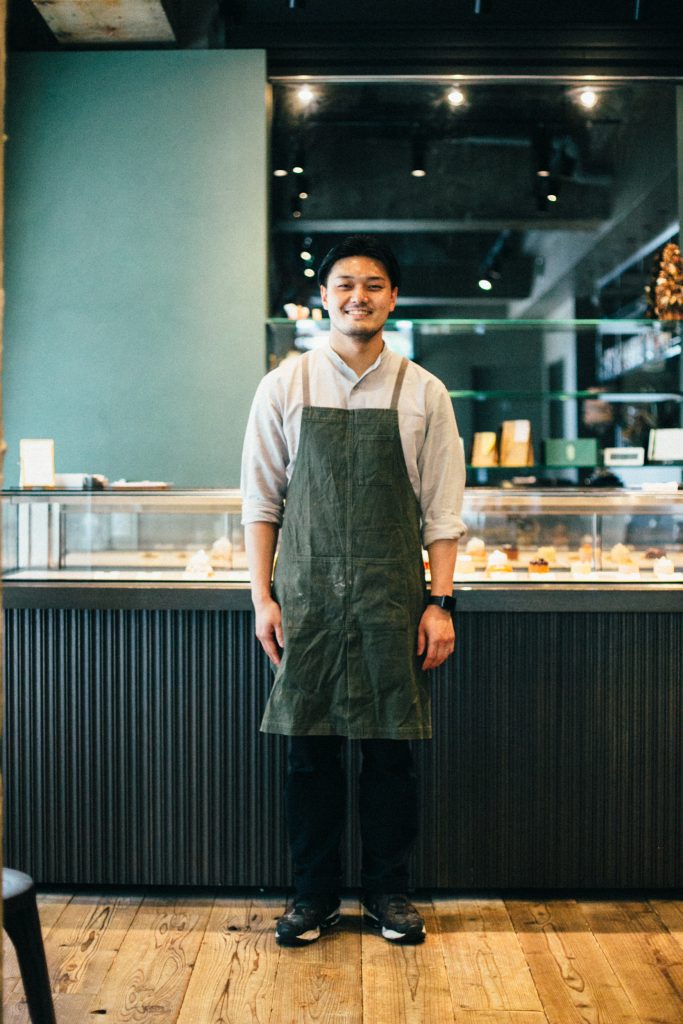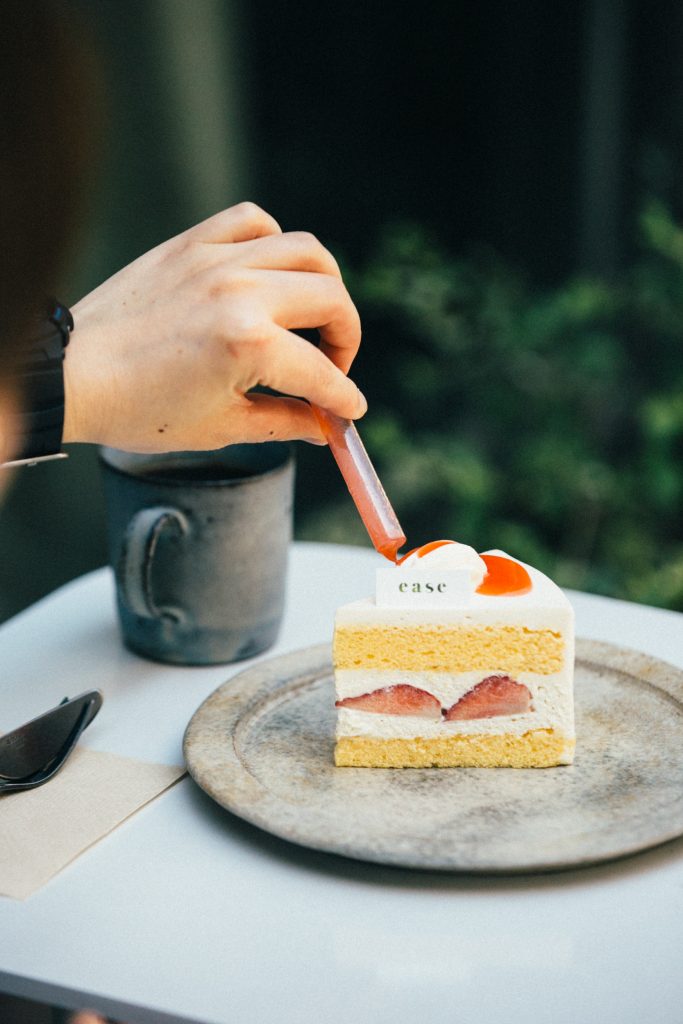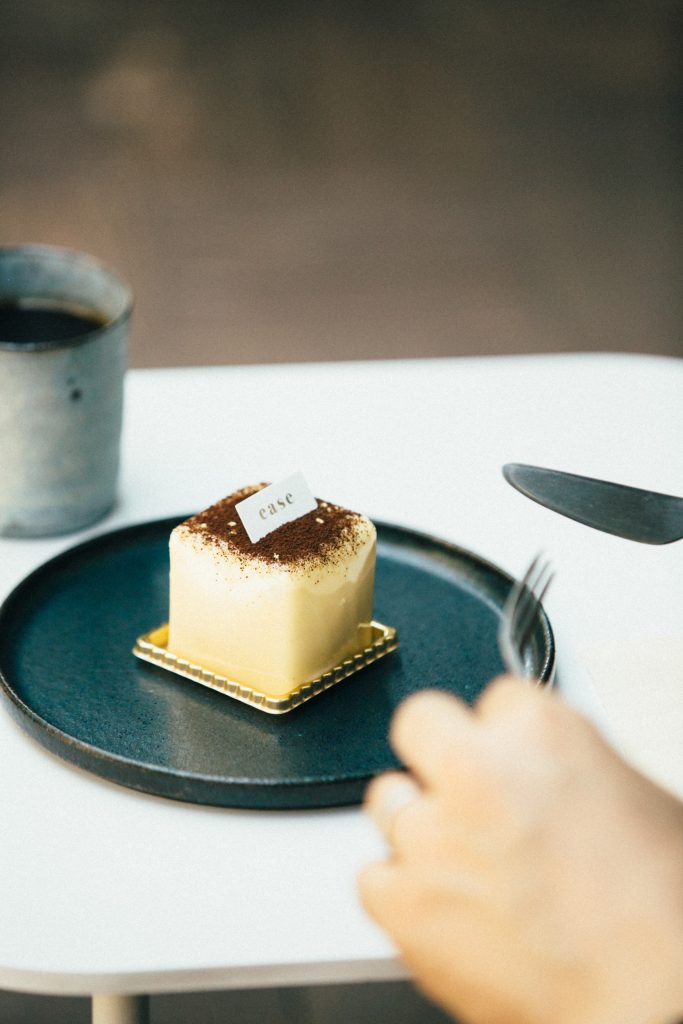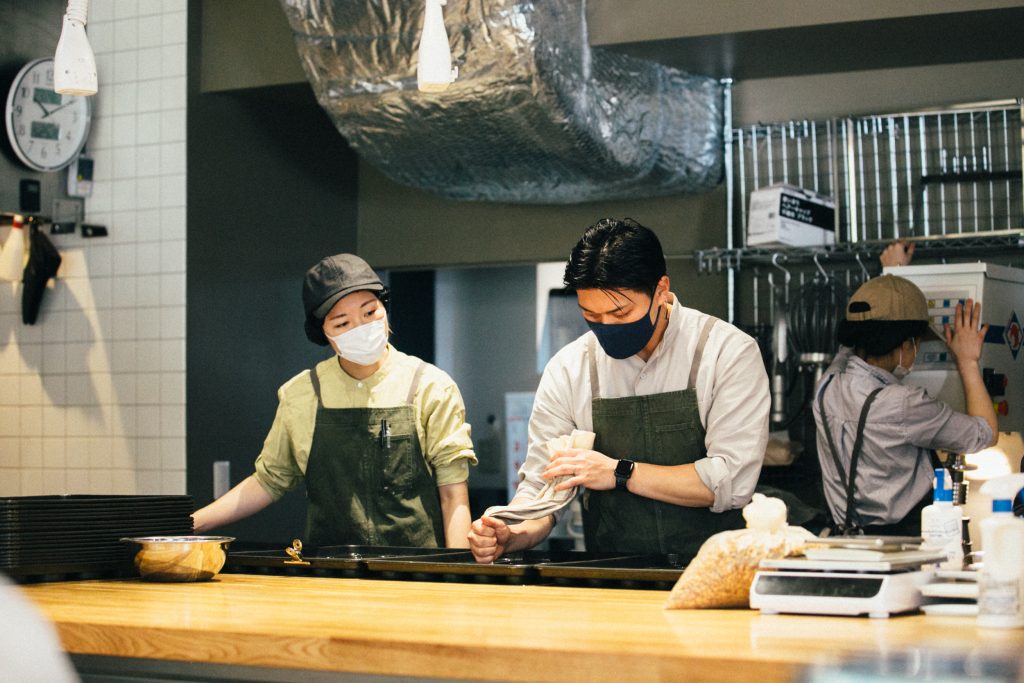


A live restaurant experience, sealed in a patisserie cake.
●When did you first become interested in making sweets?
To tell you the truth, I’ve always been more interested in cooking than in sweets. When I was in elementary school, my parents were working, so I made myself simple snacks every day. When I was searching for a culinary school, I was given the opportunity to make sweets, although I had zero experience. I felt that at that time it suited me more than cooking.
●So that’s why you went to a pastry school?
Yes, that’s right! I didn’t even realize that there were separate categories for cooking and pastry. I didn’t even know what a pastry chef was! I just thought that dessert was an extension of cooking, a part of the same field. But when I learned that there was a school specialized in pastry, it piqued my interest.
●What was it like, to actually learn how to make sweets?
I learned how to make Japanese and Western sweets. Just like with cooking, the more I tried, the more I learned. I hadn’t studied all too much, but I’ve always been the type of person who likes to practice, such as when I used to play sports. So I felt that a technical job where I could learn suited me well.
●After graduation, did you start working as a pastry chef?
The first place I starting working at after graduation was a patisserie called Hidemi Sugino (*1). Since I was inexperienced, I was beaten down quite a bit (laughs). I trained for a year and a half under strict instruction. After that, I started working part-time at a French restaurant. I wanted to study in France, so I began to save money. While I was working on desserts, I realized that being a pastry chef in a restaurant was really interesting. Even though the role is the same, the job of a patissier in a cake shop and the job of a patissier in a restaurant is completely different.
※1
A patisserie in Kyobashi. The store is owned by Mr. Hidemi Sugino, one of Japan’s leading confectioners.
●What’s the difference between a patissier in a cake shop and a patissier in a restaurant?
To put it very simply, a dessert in a restaurant only needs to hold its shape for three minutes. A dessert in a cake shop needs to hold its shape for half a day or even longer. There is a difference in the degree of freedom.
●You can change your approach quite a bit, depending on whether you want to assume that the shape will stay intact or keep it at its best for three minutes.
That’s right. How you approach taste and temperature completely changes. You could say that cake shops and restaurant patissiers are really two different professions, and what they do is completely different. I went on to become a patissier for a restaurant, so I focused on making the cake last for three minutes.
●Did you also train as a patissier in a restaurant in France?
I trained at an auberge (inn) in a small town in the Alsace region of France. I had the opportunity to help Mr. Sugimoto, a French chef, with a pop-up event, and he asked me to come work with him in Alsace. I went there on a working holiday visa and worked for about six months, and Mr Nishi from Neki also worked there.
●I heard that you and Mr Nishi from Neki lived next door to each other.
He and I lived together in a dormitory that looked like a shack behind the store. The town itself was very rural, and there was almost no bus service on weekends. If I took the bus to the supermarket in the morning, I wouldn’t be back until the evening! On my days off, the only thing I did was to go for a walk or climb the mountains. One day, Nishi and I went up into the mountains together and picked mushrooms, but we weren’t entirely sure if we could eat them or not. The mushrooms looked terrible, but we tried frying them anyway (laughs).
●That’s a great story! What did you do after you came back from France?
I knew I wanted to work in a restaurant. I worked as a pastry chef and cook in a large restaurant that catered towards weddings, kind of similar to Hiramatsu (*2) and also in a small restaurant in town with only 10 seats. Also, for a while, I worked as a chef, which was my original dream.
※2
A group that manages high-end restaurants and hotels, with a focus on the French restaurant Hiramatsu in Hiroo.
●When did you start thinking about opening your own store?
Actually, I once started and ran a small café with a friend. It was on the second floor of a building in Musashikosugi. I made the food and pastries, and my friend served the customers. I cooked everything from banquet food to pasta and French toast, but it was that experience that made me realize I wanted to open a cake shop. The café was a great success, and I ran it as a business. But then I decided to quit and joined Cynthia (*3) as a pastry chef.
※3
A one-star French restaurant in Kita-sando by Chef Ishii of the legendary BACARakar restaurant.
●What made you decide to join Cynthia as a pastry chef?
Through my experience at the cafe, I began to think seriously about my future. My dream was to open a cake shop and to make it popular. I didn’t have any desire to become famous myself, but I wanted to make a shop that people liked. So, I told myself that I needed to become a famous pastry chef in order to make the shop popular. I began to think about how to go about that process, and I consulted with Chef Ishii of Cynthia. I asked him if he would help me on my journey as a patissier in exchange for letting me work at Cynthia. I think I was 26 or 27 years old, but I suppose it was a bit shameless and brazen (laughs).
●So you had a blueprint for your future from a young age. Did your time as a pastry chef at Cynthia help you?
That’s right. Mr Ishii is a very nice person, so he left me completely in charge of the desserts, allowing me to serve them under my own name. And he actively allowed me to collaborate with other companies as well. At Cynthia, I served the customers by myself, and every time I served them, it felt like a presentation of sweets that represented me. It was also a great opportunity for us to be recognized by the media early on.
Somehow replicate the fresh food experience and feeling of eating something that someone has made on the spot; something that you would enjoy at a restaurant, and not necessarily in only three minutes.
●How did you decide to start ease in Kabutocho?
While I was working at Cynthia, I entered a cooking competition called RED U-35 (*4). I applied for the competition as a pastry chef, and I won! Chef Kan Miki Morieda (*5), who I was working with at the time, asked me if I wanted to work with him on something interesting.
※4
One of Japan’s largest cooking competitions to discover the talents of younger generations.
※5
He studied cooking at ‘Tetsuya’s’ in Australia, and after returning to Japan, trained at various well-known restaurants in various genres. He also produced CHOMPOO, a Thai restaurant located inside Shibuya Parco, and is also involved in a wide range of activities, including editing a food magazine.
●I’ve always thought that ease is a unique patisserie, both in terms of the cakes and the interior design, but what kind of concept did you start with?
I’ve worked in restaurants all my life. My only experience in a cake shop was the first job I had. I had to start the shop from zero, even though I had close to no experience. I didn’t have any know-how, but when I began to figure everything out, I realized that many patisseries are similar to each other. The store design, the way the store is presented, the way the cakes are laid out, the shape of the cakes, etc. I didn’t want to just do the same thing, the same kind of store. I started my journey in the dessert section of the restaurant, so I thought it would be great if I could incorporate that experience into my cakes. Somehow replicate the fresh food experience and feeling of eating something that someone has made on the spot; something that you would enjoy at a restaurant, and not necessarily in only three minutes.
●What were the specific points you focused on when incorporating these food experiences into the cake?
I wanted to make a cake that would leave a lasting impression on the customer. I’m not sure how many cakes people eat in a year, but I feel like no matter how many they eat, they won’t remember it a week later. Shortcakes, in particular, can be found at any cake shop in Japan. But it doesn’t leave an impression on you, you probably won’t remember which cake shop it was from either. They’re all pretty much the same, so they don’t stick in your memory. That’s why I wanted to make a cake that people would immediately associate with ease. The shortcakes have horseradish in them, the fruit changes with the seasons, and there are sauces that are served separately from the cake. The sauce is poured onto the cakes by the customers themselves at home; I think that effort, that feeling of doing something yourself is a small thing that leaves a lasting impression. I thought it would be nice if the customer was able to remember such a little thing even a year later.
●Where does the inspiration to combine shortcake with horseradish come from?
Basically, in the kitchen of a patisserie, there is absolutely no horseradish or wild vegetables. But in a restaurant, such ingredients are always within reach; I could try them out at a moment’s notice. Whenever I had a question, I could easily test and memorize the taste, like strawberries and horseradish would go well together, or wild vegetables and hyuganatsu. Thanks to this experience, when I started my own business as a patissier and decided to make a cake myself, I probably had more ideas than a normal pastry chef.
I hope that one day we will be able to create an efficient food cycle not only in our own stores but also in Kabutocho.
●In addition to Kabutocho, you also have a store at Isetan Shinjuku. I know it must be hard to maintain standards, but is there anything you keep in mind when training your staff?
I bring sweets made at ease in Kabutocho to Isetan Shinjuku every morning. We have a rather large team, about 20 people now. Some staff members can’t keep up with the level of production, or can’t respond to my expectations. When we make cakes, we score them out of 100 for quality. When I make one, I usually get a score between 80 to 100, and rarely do I mess it up. I see myself as a craftsman, so I sometimes get angry when my staff makes a 60-point cake. But that would exhaust the staff and they would end up making something that didn’t taste as good. When I thought about what to do, I realized that the criteria for customers to be impressed by the deliciousness of a cake is not only the taste but also the situation in which they eat it and who they eat it with. I thought that the added value of having bought a cake from this shop might be important as well. I have my own detailed standards, such as the color and temperature of the cake, but these standards are a world of self-satisfaction, something only I can understand. The way I relate to my staff has changed since I am no longer bound by my standards and think of delivering delicious food as an aspect rather than the main goal. Of course, I can’t forgive what I can’t forgive (laughs).
●What are your thoughts on the future of ease?
In October, I will open a chocolate store on the first floor of the Heiwa Real Estate headquarters building as a sister store of ease. I’m still working out what I’m going to do, but it’s going to be something a little different, serving chocolate and ice cream. My idea is to eventually open a bakery in Kabutocho, which would be fun. I would also like to produce cheese and add it to sweets and bread. In the cheese-making process, whey is produced, but I would like to use it as a base for drinks, and for ice cream in the chocolate store as a way to reduce food waste. I hope that one day we will be able to create an efficient food cycle not only in our own stores but also in Kabutocho.

Keisuke Oyama
Born in Saitama Prefecture in 1986. After graduating from Nihon Confectionery College, he gained experience at patisseries such as Hidemi Sugino. Afterward, he moved to France and studied desserts and cooking at a French restaurant. Upon returning to Japan, he worked as a chef-patissier at various restaurants and was awarded one star at Cynthia, as one of its founding members. In July 2020 he opened ‘ease’ in Kabutocho.
Text : Momoko Suzuki
Photo : Naoto Date
Interview : Akihiro Matsui
Keisuke Oyama
Owner of ease, patissier
People who work at the Tokyo Stock Exchange
Interesting people in Kabutocho
I’m curious about the people who work at the Tokyo Stock Exchange. I don’t usually have much contact with them despite being in the neighborhood, so I’m wondering what kind of stories they have inside that big building.



